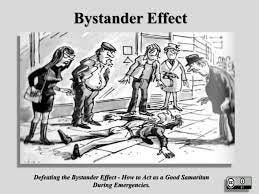The bystander effect is a social psychological phenomenon where individuals are less likely to help a victim when others are present. The greater the number of bystanders, the less likely they are to help. Thus, people benefit more when alone than in a group.
Human interaction carries a curious paradox: in the presence of groups, accountability for what is happening vanishes like smoke. It's a phenomenon known as diffusion of responsibility, which describes the tendency for individuals to feel less responsible for taking action when surrounded by potential helpers. The burden of intervention gets dispersed among the crowd, ultimately resting on no one's shoulders.
Imagine a lone witness to a mugging. Their instinct to help might be swift and robust. But add a few more bystanders and the calculus of responsibility shifts. Each person observes the others, silently assuming someone else will step forward. The urgency to act recedes, replaced by a collective shrug of indifference. This dilution of individual responsibility, fueled by a false sense of shared accountability, is the essence of diffusion.
It isn't merely a matter of apathy. Instead, it's rooted in our cognitive shortcuts. In ambiguous situations, our brains seek cues to navigate social complexities. In a crowd, the lack of immediate intervention from others becomes a signal, however misleading, that the situation may not be as dire as it seems. We fall prey to the fallacy of group ignorance, assuming that it must not be an emergency if no one else is acting.
Beyond these extreme cases, the reach of conformity permeates everyday life. It hinders teamwork, stifles innovation, and allows injustices to fester unnoticed. In group projects, shared responsibility can turn into complacency. In brainstorming sessions, fear of judgment can mute potentially valuable ideas. Fear of being judged can allow inaction to flourish.
Combating this invisible hand requires challenging our assumptions and actively reclaiming personal responsibility. Recognizing the inherent ambiguity of many situations and the deceptive allure of the bystander effect empowers us to break free from accountability. We can weave a new social sense of responsibility by cultivating a sense of personal agency and stepping forward even when others hold back.
The diffusion of responsibility is not a moral failing but a cognitive quirk embedded in human interaction. By understanding its mechanisms and fostering individual commitment, we can collectively shed the cloak of anonymity and emerge as responsible stewards of our shared world, ensuring that the burden of action never again evaporates into thin air.
Imagine a scene ripped from a nightmare: a lone person on the street, struggling against an attacker. People stream past, eyes averted, faces etched with the indifference of anonymity. The unsettling scenario embodies the chilling paradox of the bystander effect, a phenomenon where the presence of others paradoxically diminishes our inclination to help.
Why would we, social creatures driven by empathy and a sense of shared humanity, stand witness to suffering without extending a hand? The answer lies in a complex interplay of psychological factors. One potent culprit is the diffusion of responsibility. With each additional bystander, the perceived burden of intervention dilutes. We reason, "Surely someone else will act," absolving ourselves of the perceived obligation.
Another insidious actor is social influence. We instinctively scan the surrounding faces, measuring their reactions to measure our own. Are they alarmed? Offering help? If others remain passive, we interpret the situation as non-urgent or, perhaps, a figment of our imagination. That way of thinking is called conformity, and it's driven by a desire to blend in, silencing our inner voice and stifling our impulse to act. The pressure toward conformity forces inaction.
Beyond these internal dynamics, the very nature of the situation can play a role. Ambiguity about the distress, personal anxieties, or fear of negative consequences can further paralyze us into inaction.
However, hope is still possible. Recognizing the bystander effect is the first step towards counteracting its grip. By promoting awareness and fostering a sense of individual responsibility, we can empower ourselves and others to rise above the chilling calculus of inaction. Training programs equip individuals with the skills to identify emergencies, assess their safety, and take decisive action. Encouraging open communication and active bystander interventions within communities can further erode the walls of indifference.
Sometimes, people may convince themselves that no one else is taking action, so why should I? Part of the motive for inaction may include a fear of danger. Self-protection in the face of perceived danger often promotes passivity.
Similarly, if an emergency emerges near a group, everyone in the group may not help. They cannot help because they see other people not helping and assume that there is no emergency and that they have misjudged the situation. Once again, there is a fear of looking inadequate.





We see this so often. This is a very good and important read.